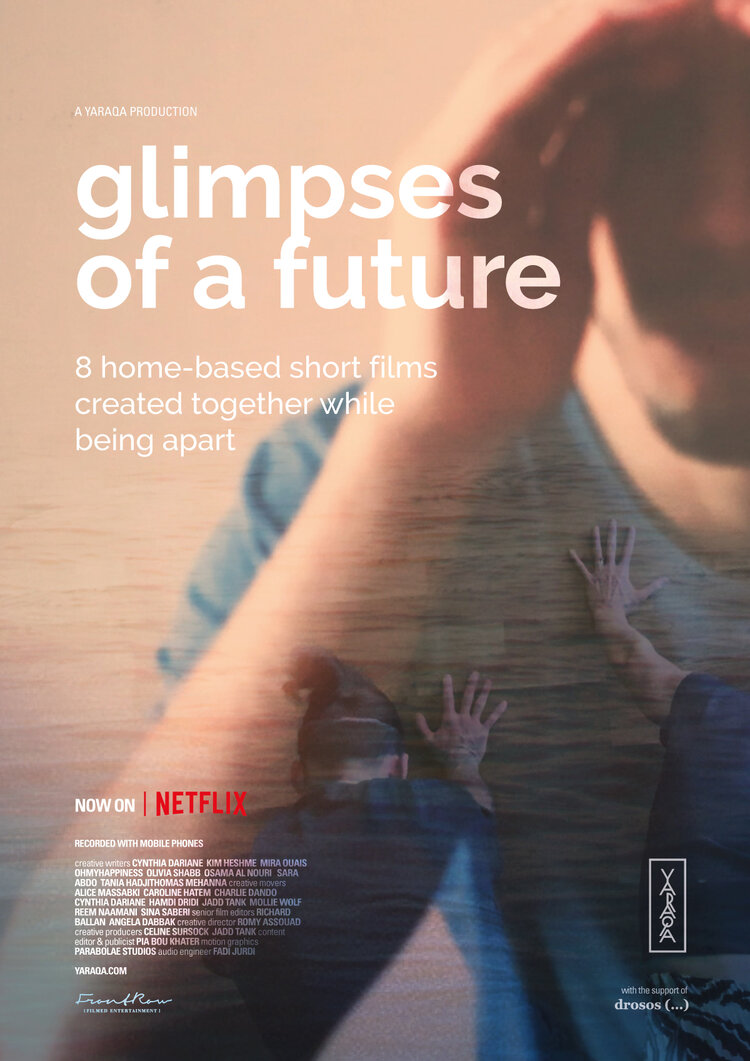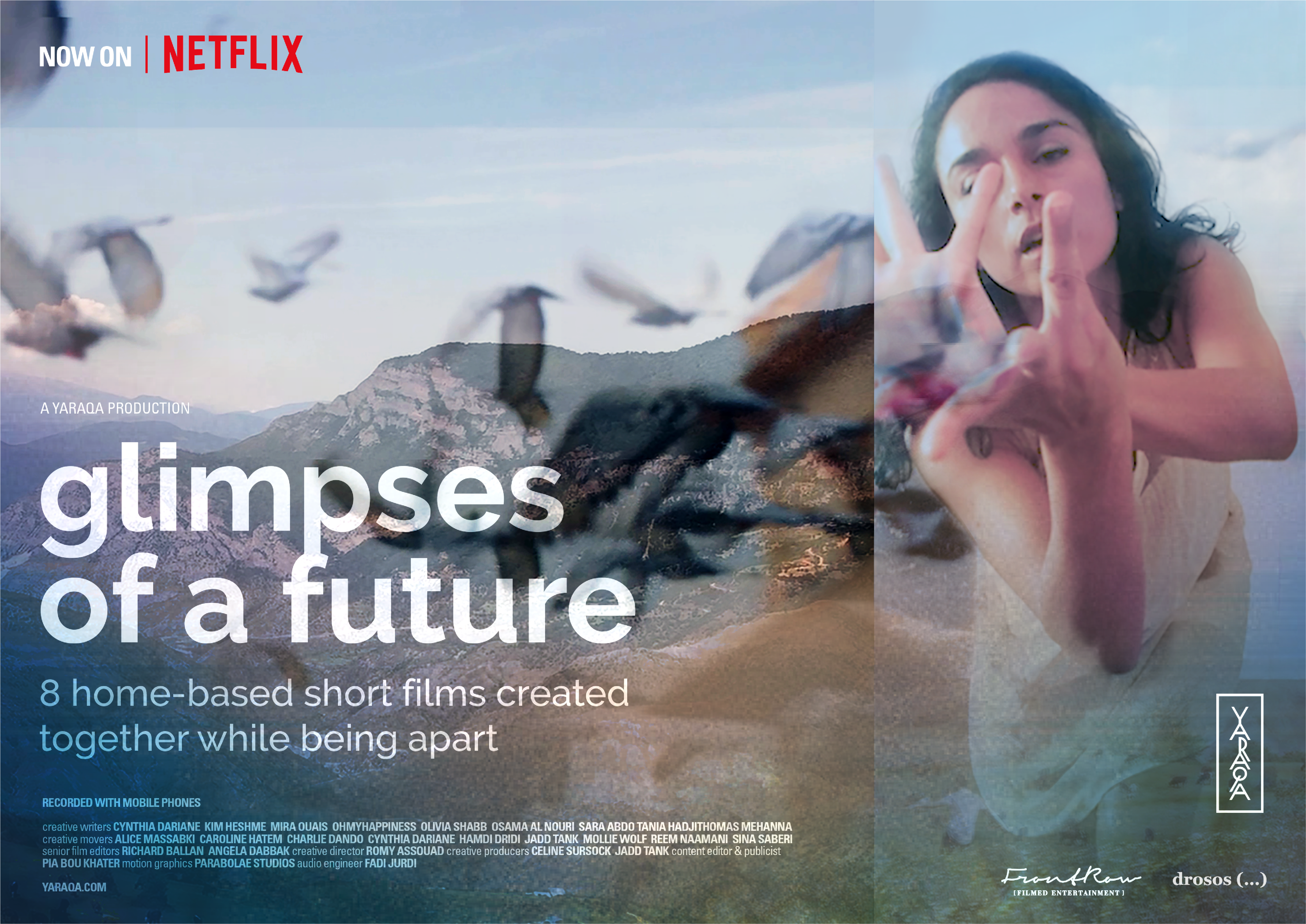‘Glimpses of a Future’ is a new docuseries available on Netflix that combines writing and movement to answer the following question: If you can imagine the future, what does it look like? During the first Covid-19 lockdown, eight writers and nine dancers from Lebanon, France, Jordan, Iran and the United States came together to reimagine the future. The result is a series of eight episodes where dance reshapes the writing through visualization and embodiment. ‘Glimpses of a Future’ is an ode to collaboration, a call to action for artists and audiences to build up a new future, even if apart. Each episode opens up a conversation around emotions, hopes, dreams, acceptance, worries, vulnerability and social justice. This is a docuseries that highlights what it means to be a human right now.
We spoke with Romy Assouad and Krystelle Karam from Yaraqa, the Lebanese social enterprise and production company behind the creation and production of this series. We chatted about the creative process behind ‘Glimpses of a Future’ and how collaboration is key in the world we are living in now.

DAJ: What’s the mission behind the work of Yaraqa?
ROMY: Yaraqa started in 2014 intending to bring together dance artists and other creative professionals and business experts from other fields. So, a lot of what we do is really push boundaries and create more cross-sectorial collaborations, explore what it means to innovate in the dance sector and work on sustainability, as I believe that we can show that Performing Arts is a sector that is creative, but also economically very vibrant. We want to talk about it and create impact at the same time – that is why we work on two layers. We have an R&D, Research and Development Lab, where we create the space to experiment, trying new things and develop new projects without waiting for them to come. During these Labs, we experiment and connect with the other industry professionals, and this is actually how ‘Glimpses’ started, it started from our Lab. At the same time, we work with artists to capacitate them on projects, involving business thinking or marketing. This is all under our Lab. And then we do creative production, particularly dance projects and workshops.
DAJ: ‘Glimpses of a Future’ is a docuseries created as a creative response to the Covid-19 first lockdown in March 2020. What was the starting point of this series?
ROMY: So many things have happened in Lebanon, particularly, that I need to go back slightly before March 2020. When the revolution started in Lebanon on October 17, we were getting ready for a public R&D Lab with two days of workshops. We needed to postpone it and ended up doing a smaller adapted version. Then, in March 2020, we were planning to do it again; we had everything ready, we invited another round of people but then the lockdown happened and, again, it got postponed. By that time, we realised we were in a completely different sphere and we were quite responsive about it, in the way we work as Yaraqa – we are very reactive. And as a lot of what we do involves innovation, we thought about how to embrace this new reality that would be going to stick around for a while.
We started thinking of creating a digital campaign on social media that could bring the community together, where we were not just disseminating work, but creating new work online. We took on this challenge and soon we realised that a lot of questions were being asked around us – and we decided to bring these questions to our creative work. At that point, we started an online Lab based on the idea ‘what is the biggest challenge right now?’ and we realised that there were so many changes and uncertainty, not only about the present but also about the future.
So, the concept behind ‘Glimpses of the Future’ started by reimagining the present and imagining the future. And while we were preparing to imagine the future, we wanted to address this question: ‘how is the future different?’. We thought that if you were able to visualise it, to embody it, you were one step closer to making it your future, you were able to control it in a positive sense. And in Lebanon, by that time, we didn’t have only the lockdown. Despite the revolution calming down we were passing through a huge economic recession. That is why it was even more important to feel like you have some kind of control, some kind of decision about what was happening. We imagined the future we would like to create and embodied it. So this is how it all started: by reimagining the future. As usual, we worked in cross-sector collaborations, so we opened this creative process to writers, and created these small videos, eight episodes in total.
DAJ: This is a collaborative project between writers and dancers around the world. How was the creative process?
ROMY: For this project, we followed the principles of visualising and embodying. We decided to start with the writers: we invited not only professional writers, but also people who express themselves mainly through writing – which made us have different backgrounds, like psychologists, people working in tourism or screenplay writers. It is very diverse. We really wanted to create a voice of these different people.
We asked them to close their eyes and, if they think about the future, how does it look like? We asked them to try as much as possible to imagine how it looks, how they were feeling about it, what is still there and if something is changed. And after they produce the pieces of writing, we sent each text to one different dance artist. They did not meet each other. Dancers were free to interpret the text by giving it a shape through movement. They recorded the videos using mobile phones. What was interesting was seeing how dancers responded to the texts, how the writing and the movement came together. Afterwards, we worked with our film editors to piece them together. What was beautiful about it was that every person saw a different glimpse of the future, creating layers on top of each other. Every person added a layer. And there was a narration and music that was added. And only by the end, we showed them the work and they met each other.
We knew that we had to work at a distance, that we were isolated from each other. We thought that if we embrace this idea of distancing it might work. Like, how you can create something very personal to you, but then you distance yourself from it and allow others to add their own layers to it. This is why, in a way, when you watch the series, it feels like a discussion has been taking place with everyone involved. But it is just every person putting something so authentic and personal. And thanks to the brilliant film editors, we were able to bring out the narrative of each episode. It was a beautiful creative process and when collaborators met each other the reactions were amazing.
DAJ: Each episode shares emotions, thoughts and hopes about the future. For you at Yaraqa, what’s your glimpse of the future right now?
KRYSTELLE: Well, it all started as a social media experiment and later became this docuseries on Netflix. At the same time, on August 4 we had the blast in Beirut and everyone was picking up the numbers and trying to understand the present. At some point, people could not relate to the future or even think about the future. This was when Yaraqa felt there was a need to connect with the international community and connect movement artists. That was when Yaraqa started publishing ‘Glimpses of the Future’ on Netflix. And this is how we started looking at the future during times of uncertainty: to bring together artists and building up international collaborations.
ROMY: It is exactly what Krystelle was saying. A lot of our collaborators are Lebanese, we are all Lebanese as a team. But some of us are not based in Lebanon anymore. And we have also been working with people from the region but also the US and Europe. With what has been happening over the past year, with the blast taking place, it pushed us even further to open up to the outside world and get the voices louder, not just for us but also for the artists who are working with us. We need to push for more financial support, for more exposure. So, for us as Yaraqa, we imagine a bittersweet future – it has been hard with everything that is happening, but there are ways to make a difference. There are ways to get our voice louder. And I also think that Covid accelerated some things we used to discuss before, such as stepping into the digital sphere more.
DAJ: By the end of each episode, we watch the message ‘It’s time to warm-up for a different tomorrow’. What’s the tomorrow you would like to see in the arts sector?
KRYSTELLE: ‘Glimpses of the Future’ embraces collaboration with people around the world and different professional sectors, which serves our vision of bringing together international creatives. And I find it interesting how Yaraqa is moving aligned with everything that is happening around the world, with dance in the digital space. Another interesting take is the creative production. We are working on streaming dance into several industries through creative productions for films, even with companies that are not even close to dance. We are always looking for creating new opportunities for artists and connecting them with other professionals and business experts.
ROMY: Physicality in dance is extremely important of course, but we need to have other options as well. That is why we create more collaborations across industries and jump onto new conversations. What we are doing at this moment is exploring what does it mean to bring dance into a film. Not a conventional dance film, but instead thinking about how we can tell a story in a film with dance being the main medium and create a film that everybody could watch and not just for dance festivals. We want to reach other people as well. After watching ‘Glimpses of a Future’, a lot of people said they did not feel they were watching dance. And for me, this is a plus because it means that they connected with it and saw value in it. It does not matter that you are undermining dance, it just means that they can establish a deeper connection to an art form that sometimes is so niche. We must bring dancers into these new collaborations, but also the audience. What does dance mean to the audience? If we forget about that, we won’t be able to create sustainability. Sustainability needs to be on so many fronts. I think the arts sector needs to innovate more to achieve this sustainability. And here at Yaraqa, that is what we have been advocating and what we will keep doing in the future.
‘Glimpses of a Future’ is now available on Netflix. You can watch the trailer below:
